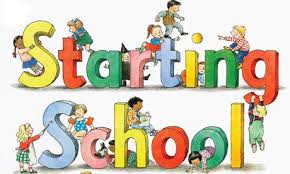Here are some helpful hints from Mummysmiles to get mums & little ones ready for school:
The summer holidays are nearly over, and our thoughts are slowly moving from plum puddings and Christmas Trees, to lunch box snacks and school books. Last year, we started talking about making
preparations for Prep, and we continue this today with help from all the readers who have sent me their suggestions.
Every year, thousands of new school-mums bid farewell to their little ones as they face a formal school environment for the very first time. What a significant and exciting time for these children and their families. But as with any big milestone, there can be some feelings of trepidation, possibly some anxiety about the unknown. This is perfectly normal!!
Just remember, preparation is key! And with the following tips, you can help make the transition into school smooth, exciting and enjoyable.

1. Encourage self sufficiency: Insist your child carries their belongings from day one. If you carry all their items for them the first day or week, they will think this is how it’s to be done. It’s then very difficult to change expectations.
2. Make new friends: Prep is an opportunity for your child to widen their circle of friends. Set them on the right track by smiling and greeting people as you enter the school and make your way to the classroom. If you are friendly to others, your child is likely to follow their lead.
3. Watch for tiredness: Prep is a very busy time for young children as they learn and develop, and they will become tired more easily. It is very important to be aware of this. Are they over-reacting to small incidents and does it take them a long time to get to sleep? These are signs of over-tiredness. You may need to compensate for this by having more wind-down time at the end of the day. It is important to put into place good bed-time routines now so you are ready for next year.
4. Have essentials ready: It’s important that your child has all the required equipment when they head off for their first day. A missing book or pencil case may not seem like much to you, but it will be a big deal for them. Make sure they have their hats, water bottle and everything else that they may need. A calendar on the fridge stating Library, PE days or when things are due back at school is helpful.
5. Think about the size of their school bag. Those cute little bags are adorable but can they fit your child’s spare underwear/clothes, lunch box/bag, drink bottle, hat, jumper (because it will most often come off), art work, notes and their items for news? (Kaz) If you are using the school’s school bag, make sure you use a bag tags so that they can identify their own bag. Make sure they put their own bag and hat onto the port racks so that they know where to look for it at break times. (Maree)
6. Covering books in one colour or pattern is a great idea. If your child is in primary school and keeping all their books in their desk make it easy for your child to find the different books with a coloured spot or label on the spine. Imagine a child with 3-5 books in their desk piled on top of each other and then a pencil case or two on top. If they are all in the same contact how do they find their writing book quickly? (Kaz)
7. To make it easier for young children to find what they need in their pencil cases, pop separate items in the little cheap clear pencil cases that you get at the $2 shops. Colouring pencils in one, crayons in another, writing pencils, rubber, pencil grip in another etc., and then put all of the little pencil cases into the larger one. It makes it easier for them to find what they need = one less thing for them to worry about! (Maree)
8. Start the kindy routine a good few weeks in advance (over the summer holidays) so that it’s one less thing to adjust to at the start of school eg. wake up times/breakfast times/make bed etc or whatever you want to implement to get out the door on time and with everything that needs doing done! (Amanda)
9. Be brave so they are too, you may be surprised how emotional you will be when it comes time to say goodbye, so put on your bravest face, no matter how distressed they are and remember when it comes time to pick them up, they will be talking non stop about what they did all day. (Kylie)
10. Take a moment to pause and reflect. This is a really exciting time – your child is starting a journey which will help to shape them as a person over the next 13 years. You have done an amazing job as a Mum. You have nurtured your baby from the little newborn to the capable and confident little person that they are today. As you walk back out of the school gate after drop off, pat yourself on the back. Good job, Mum.
Vanessa X











